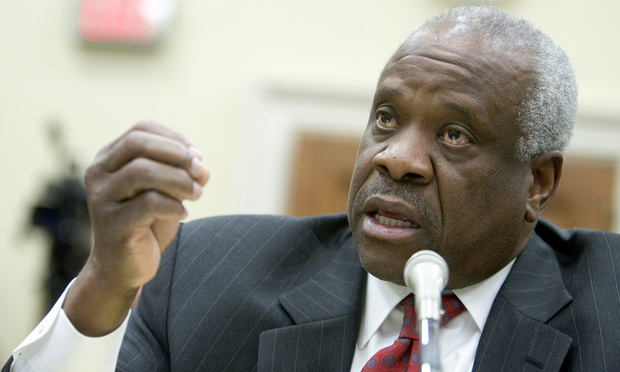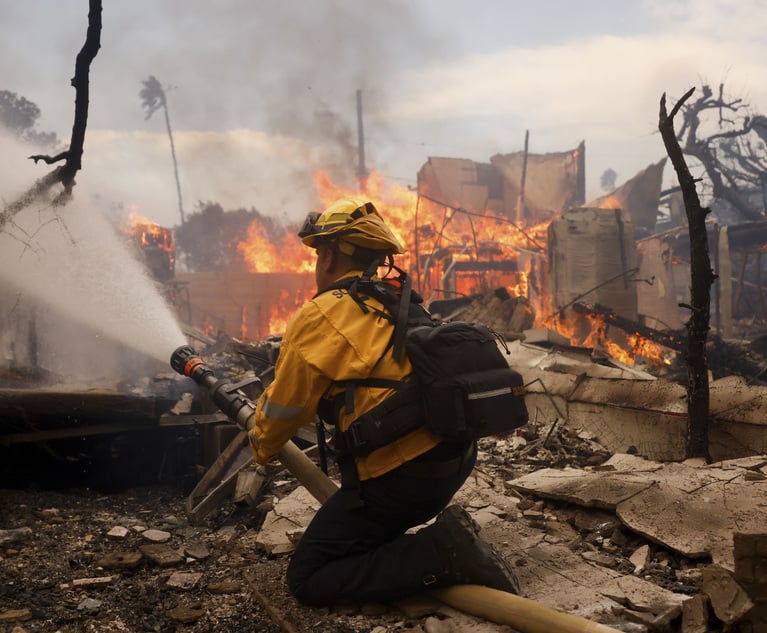Justices, With Kavanaugh Seated, End 9-Year Avoidance of Gun Regulations
Only three justices since 2008 have indicated a desire to hear Second Amendment challenges: Justices Clarence Thomas, Samuel Alito Jr. and Neil Gorsuch.
January 22, 2019 at 03:07 PM
6 minute read
 Justice Anthony M. Kennedy administers the Judicial Oath to Judge Brett M. Kavanaugh. Credit: Fred Schilling, Collection of the Supreme Court of the United States
Justice Anthony M. Kennedy administers the Judicial Oath to Judge Brett M. Kavanaugh. Credit: Fred Schilling, Collection of the Supreme Court of the United States
After nearly a decade and numerous denials, the U.S. Supreme Court will jump back into Second Amendment gun regulations. Is Justice Brett Kavanaugh the reason?
“It's hard not to think that Kavanaugh's replacement of Justice [Anthony] Kennedy was key here,” said Second Amendment scholar Adam Winkler of UCLA Law School. “The court has turned aside one gun case after another for nearly a decade, and almost immediately [after Kavanaugh is on the court] they take a Second Amendment case. It's hard not to draw that inference.”
The case in which the justices granted review Tuesday could result in a limited, for-this-case-only decision, according to Winkler. Or the outcome could be a major ruling on two fundamental questions unanswered by the justices' landmark Second Amendment decision in 2008: What is the constitutional test for gun regulations, and when can firearms be carried in public?
Tuesday's grant—with no signed dissents—came in a challenge to New York City's “premises” license law, which limits the transport of handguns to a home or seven shooting ranges within the city limits. Besides relying on the Second Amendment, the challengers, led by Kirkland & Ellis partner Paul Clement, also claim the law violates the right to travel and the commerce clause.
“This is such an easy case,” Second Amendment litigator Stephen Halbrook said. “This law doesn't exist anywhere else in the country, a total outlier.” The challenge could have won review even if it had come to the court before Kavanaugh came on the court, he said.
Halbrook agreed with Winkler that the justices could use the case to answer what constitutional test must be used for gun regulations. “Why else would they take a case like this if not to give guidance to lower courts which have been in rebellion against Heller [the landmark Second Amendment ruling] since 2008?”
The rash of challenges to local and state gun regulations turned away by the high court has included bans and restrictions on concealed carry and open carrying of firearms in public.
The high court's most recent major Second Amendment rulings were in 2008—District of Columbia v. Heller, finding an individual right to keep a weapon in the home for self-defense—and 2010's McDonald v. City of Chicago, which applied the Second Amendment to the states. In both cases, the court divided 5-4 along conservative-liberal ideological lines, with Kennedy in the majority.
 Justice Clarence Thomas (2015). Credit: Diego M. Radzinschi/ ALM
Justice Clarence Thomas (2015). Credit: Diego M. Radzinschi/ ALMThe inference that Kavanaugh made the difference in Tuesday's grant was bolstered by the fact that only three justices since 2008 have indicated a desire to hear Second Amendment challenges: Justices Clarence Thomas, Samuel Alito Jr. and Neil Gorsuch. Thomas, in particular, has sharply criticized his colleagues for making the Second Amendment a “second-class right” and a “constitutional orphan.”
“If a lower court treated another right so cavalierly, I have little doubt that this court would intervene,” Thomas wrote in a dissent last year. “But as evidenced by our continued inaction in this area, the Second Amendment is a disfavored right in this court.”
Four votes are required to hear a petition and Kavanaugh, confirmed to the bench in October, may well have been the fourth. The inference also would be consistent with Kavanaugh's strong pro-Second Amendment views when he sat on the U.S. Court of Appeals for the D.C. Circuit.
In 2016, in what is known as Heller II, Kavanaugh dissented from the 2-1 panel decision upholding the District of Columbia's ban on semi-automatic rifles and requirements for gun registration.
“There is no meaningful or persuasive constitutional distinction between semi-automatic handguns and semi- automatic rifles,” Kavanaugh wrote. “Semi-automatic rifles, like semi-automatic handguns, have not traditionally been banned and are in common use by law-abiding citizens for self-defense in the home, hunting, and other lawful uses. Moreover, semi-automatic handguns are used in connection with violent crimes far more than semi-automatic rifles are.”
Winkler, author of “Gunfight: The Battle Over the Right to Bear Arms in America,” suggested that the new case could result in no major Second Amendment statement because the city's law is unusual in its restrictions on the transportation of firearms.
But it also could end with major pronouncements on two key, unresolved Second Amendment questions, he said.
“The biggest unanswered question is whether you have the right to have a gun in public,” he said. “People think about that issue in terms of concealed carry permits. This case presents the issue in an unusual and unexpected way—whether you have the right to take a gun out of home and move it in public to transport it. It's possible to use the case to articulate broad protections for a right to transport firearms in public.”
The other major unanswered question is what test is to be used to decide whether gun regulations run afoul of the Second Amendment. The Supreme Court in 2008 only said that neither rational basis (the lowest form of scrutiny) nor a balancing of interests was appropriate. Since then, most courts have applied a form of heightened scrutiny.
“We don't know how that's going to go,” Winkler said. “This case isn't the best vehicle, but they could well do it.”
Read more:
Supreme Court Will Hear Firearms Case, Testing New York 'Premises' Law
Clarence Thomas, in Dissent, Asserts Gun Rights Aren't 'Favored' at High Court
Thomas Calls the 2nd Amendment a 'Constitutional Orphan.' Stevens Says Get Rid of It.
This content has been archived. It is available through our partners, LexisNexis® and Bloomberg Law.
To view this content, please continue to their sites.
Not a Lexis Subscriber?
Subscribe Now
Not a Bloomberg Law Subscriber?
Subscribe Now
NOT FOR REPRINT
© 2025 ALM Global, LLC, All Rights Reserved. Request academic re-use from www.copyright.com. All other uses, submit a request to [email protected]. For more information visit Asset & Logo Licensing.
You Might Like
View All
'Religious Discrimination'?: 4th Circuit Revives Challenge to Employer Vaccine Mandate
2 minute read
4th Circuit Revives Racial Harassment Lawsuit Against North Carolina School District
3 minute read

DOJ, 10 State AGs File Amended Antitrust Complaint Against RealPage and Big Landlords
4 minute readTrending Stories
Who Got The Work
J. Brugh Lower of Gibbons has entered an appearance for industrial equipment supplier Devco Corporation in a pending trademark infringement lawsuit. The suit, accusing the defendant of selling knock-off Graco products, was filed Dec. 18 in New Jersey District Court by Rivkin Radler on behalf of Graco Inc. and Graco Minnesota. The case, assigned to U.S. District Judge Zahid N. Quraishi, is 3:24-cv-11294, Graco Inc. et al v. Devco Corporation.
Who Got The Work
Rebecca Maller-Stein and Kent A. Yalowitz of Arnold & Porter Kaye Scholer have entered their appearances for Hanaco Venture Capital and its executives, Lior Prosor and David Frankel, in a pending securities lawsuit. The action, filed on Dec. 24 in New York Southern District Court by Zell, Aron & Co. on behalf of Goldeneye Advisors, accuses the defendants of negligently and fraudulently managing the plaintiff's $1 million investment. The case, assigned to U.S. District Judge Vernon S. Broderick, is 1:24-cv-09918, Goldeneye Advisors, LLC v. Hanaco Venture Capital, Ltd. et al.
Who Got The Work
Attorneys from A&O Shearman has stepped in as defense counsel for Toronto-Dominion Bank and other defendants in a pending securities class action. The suit, filed Dec. 11 in New York Southern District Court by Bleichmar Fonti & Auld, accuses the defendants of concealing the bank's 'pervasive' deficiencies in regards to its compliance with the Bank Secrecy Act and the quality of its anti-money laundering controls. The case, assigned to U.S. District Judge Arun Subramanian, is 1:24-cv-09445, Gonzalez v. The Toronto-Dominion Bank et al.
Who Got The Work
Crown Castle International, a Pennsylvania company providing shared communications infrastructure, has turned to Luke D. Wolf of Gordon Rees Scully Mansukhani to fend off a pending breach-of-contract lawsuit. The court action, filed Nov. 25 in Michigan Eastern District Court by Hooper Hathaway PC on behalf of The Town Residences LLC, accuses Crown Castle of failing to transfer approximately $30,000 in utility payments from T-Mobile in breach of a roof-top lease and assignment agreement. The case, assigned to U.S. District Judge Susan K. Declercq, is 2:24-cv-13131, The Town Residences LLC v. T-Mobile US, Inc. et al.
Who Got The Work
Wilfred P. Coronato and Daniel M. Schwartz of McCarter & English have stepped in as defense counsel to Electrolux Home Products Inc. in a pending product liability lawsuit. The court action, filed Nov. 26 in New York Eastern District Court by Poulos Lopiccolo PC and Nagel Rice LLP on behalf of David Stern, alleges that the defendant's refrigerators’ drawers and shelving repeatedly break and fall apart within months after purchase. The case, assigned to U.S. District Judge Joan M. Azrack, is 2:24-cv-08204, Stern v. Electrolux Home Products, Inc.
Featured Firms
Law Offices of Gary Martin Hays & Associates, P.C.
(470) 294-1674
Law Offices of Mark E. Salomone
(857) 444-6468
Smith & Hassler
(713) 739-1250










